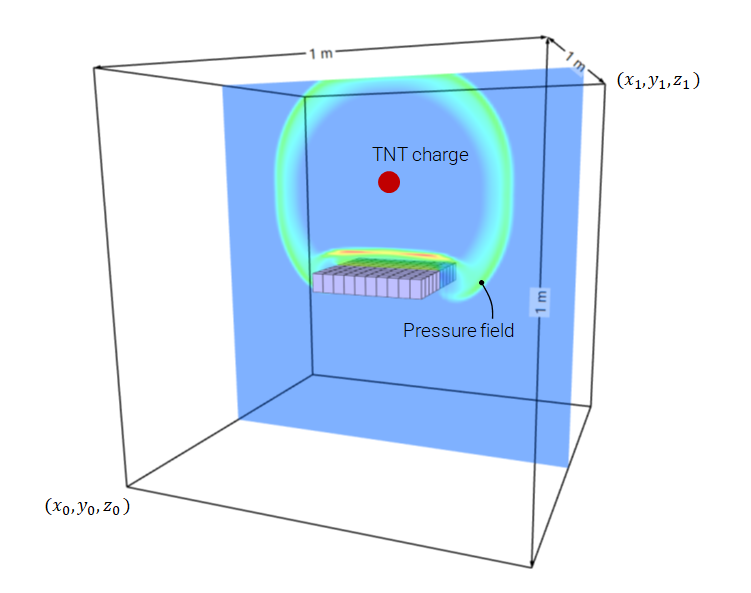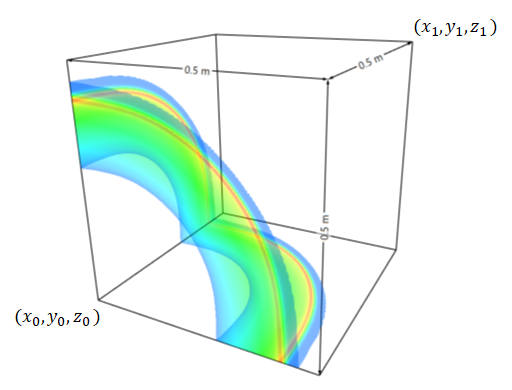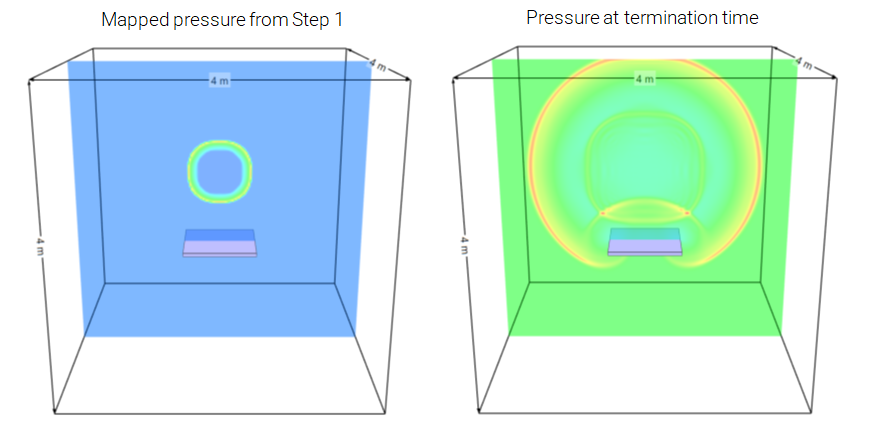CFD_DOMAIN
CFD
"Optional title"
coid, scheme
entype, enid, $\Delta$, air, geo_update, xsmooth, blocking_update, blocking_type
$x_0$, $y_0$, $z_0$, $x_1$, $y_1$, $z_1$
bc${}_{x0}$, bc${}_{y0}$, bc${}_{z0}$, bc${}_{x1}$, bc${}_{y1}$, bc${}_{z1}$
$t_{end}$
Parameter definition
Description
CFD_DOMAIN activates a built-in CFD solver for compressible flow. The command is used to define the computational domain (location in space and boundary conditions), grid size, and to specify the interaction with embedded FE parts.
Accompanying commands are CFD_GAS, CFD_HE and CFD_DETONATION. These commands are used to fill the CFD domain with gases and high explosives and to define detonation points (if applicable).
The spatial pressure smoothing option is used to filter noise in the CFD-FE coupling interface. Typical xsmooth values range between 0 (no smooting) and 10 (strong smoothing).
CFD cells that are intersected by the Finite Element structure are treated as dead (empty). The geo_update parameter controls the interval (number of time steps) at which the intersection is updated.
The blocking_update parameter activates a check that prevents interaction between CFD cells and Finite Element faces shielded by (located behind) other faces. For performance reasons, this check is inactive by deafult.
blocking_type controls the level of intersection (or overlap) between the FE and CFD grid for a cell too be treated as dead. As default a small overlap is enough for a cell to be deactivated. This ensures that gas will not leak through thin structures. However, a consquence is also that a larger CFD region will be deactivated than the physical volume of the overlapping FE object.
Full coupling is automatically activated between CFD and SPH and between CFD and discrete soil particles.
Example
Air blast loaded rigid plate
A simple example with a TNT charge (diameter $60 \mathrm{mm}$) detonated above a rigid plate at stand-off distance $200 \mathrm{mm}$.

Alternative 1 - air is defined with the command CFD_GAS
Alternative 2 - global domain is filled with air by setting air=1 in CFD_DOMAIN
Restart and mapping from fine to coarse grid
Large scaled distances are computationally challenging. The initial shock wave formation might require a grid resolution that is too fine to be used for the global domain. A possible solution is to model the process in two steps:
Step 1 - detonation and initial blast wave formation
This initial part of the process is modeled with a fine grid. Symmetry conditions are utilized. At termination a file impetus_state_cfd1.bin is generated. This file contains information about the final CFD state, i.e. densities, energies and velocities in all cells of the CFD grid.

Step 2 - blast wave propagation
The results from Step 1 are imported and mapped to a corser grid and the shock wave propagation can be tracked over larger distances. Note that the solver identifies the 1/8 symmetry conditions from Step 1 and automatically mirrors the results to full 3D. The binary state file from Step 1 (impetus_state_cfd1.bin) is included from cfd_data.k. Hence, the positioning parameters in the INCLUDE command will also control the positioning of the data in the binary state file.

